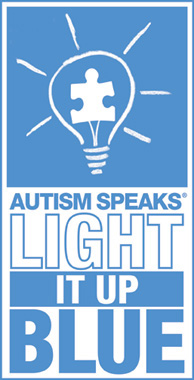Light It Up Blue for Autism Awareness Month
One of the most prevalent neurological disorders in the world […]

An estimated 1 in 88 children in America each year are diagnosed with the disorder, which affects boys as many as five times more frequently than girls. The Autism Spectrum covers an incredibly wide variety of conditions with vastly different characteristics. Some children with ASDs have difficulty with social interactions, and find the idea of school intimidating; others excel at academics, besting their peers in topics ranging from math to art. Some engage in repetitive behavior or have limited motor capabilities, while others may experience few or no physical symptoms. Additionally, onset of the condition usually occurs between the child’s first and third birthday. Given that all children develop at their own pace during their early years of life, this makes diagnosis difficult.
Often, early-onset neurological health disorders can have purely genetic causes, but that doesn’t seem to be the case with autism. Though scientists continue to search, studies have been inconclusive, showing a correlation between autism and genetic syndromes of less than 20%. Instead, it seems likely that autism may be caused by a combination of both genetic predispositions, which can be hereditary, and certain environmental triggers, particularly during the child’s gestation or birth. These triggers can sometimes cause the genes to mutate, causing autism.
To further complicate matters, there is no known medical test for ASDs. Unlike many disorders, which can be identified in the blood, ASD must be diagnosed through behavioral evaluations. Doctors and psychologists base their diagnosis on observation of the child’s behavior, and interviews with the child and his parents. If you notice your child missing major milestones, such as not babbling or gesturing by the age of one, take your child to a therapist. Early diagnosis is vital, as studies have shown that early intervention therapy can dramatically help those on the spectrum and their families live a normal life. Some even manage to work their way off the spectrum, and no longer meet the criteria for diagnosis. However, many severe cases require lifelong treatment.
Fortunately, recent studies have shown that there may be a way of lowering your baby’s risk of ASDs. A study of over 85,000 pregnant women showed that the consumption of at least 600 mcg of folic acid every day for the months before conception and during pregnancy lowers the risk of autism by up to 40%. We’ve sung the praises of folic acid before, and now it seems clearer than ever that this important vitamin is vital to your baby’s health. The crucial time period begins four weeks before conception and extends into the first two months of pregnancy; after the eight-week mark, it seems to have no effect. Additionally, lower your exposure to any environmental toxins. They can come from the usual culprits, like chemical cleaners, and from surprising sources, like older dental fillings (which can contain mercury).
While there are many services available to those living with ASDs, resources are limited, and can often be costly. To volunteer or donate, visit Autism Speaks.







